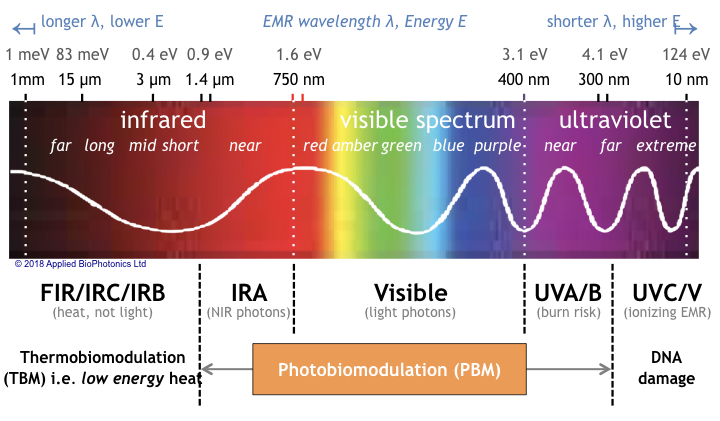3 Simple Techniques For Photobiomodulation
Table of ContentsAll About PhotobiomodulationPhotobiomodulation Can Be Fun For EveryoneAll About PhotobiomodulationSome Known Factual Statements About Photobiomodulation
Laser therapy is a clinical treatment that uses focused light to boost a process called. Throughout PBM, photons enter the cells and communicate with the cytochrome c complex within mitochondria. This interaction sets off an organic cascade of occasions that leads to a boost in cellular metabolism, which can in addition to speed up the healing procedure.There is consensus that the application of a restorative dose of light to damaged or dysfunctional cells leads to a cellular reaction moderated by mitochondrial mechanisms. Photobiomodulation. Research studies have actually shown that these adjustments can affect pain and inflammation, in addition to, cells repair work
Modifications in ATP, reactive oxygen types and nitric oxide comply with light absorption by Cc, O. These effects are redox state and dosage reliant.

Photobiomodulation Fundamentals Explained
PBM tools have actually been cleared for marketing by FDA through the Premarket Notification/510( k) process as adjunctive gadgets for the short-term alleviation of discomfort. These clearances were based upon the discussion of medical data to support such insurance claims (Photobiomodulation). In this treatment, a light is placed near or touching the skin, allowing the light power (photons) to permeate tissue where it connects with chromophores found in cells causing photophysical and photochemical modifications that lead to modifications at the molecular, mobile and cells degrees of the body
Interestingly, current research study indicates that light can boost performance in typical tissues and cells. The prospective applications of PBMT are various and are being checked out experimentally at the basic science, pre-clinical and medical degree. The current professional uses are for the relief of pain and swelling and the treatment of sporting activities injuries.

The therapy parameters and variety of sessions required for PBMT depend on area and cause. PBMT normally calls for even more than one treatment for optimum discomfort alleviation. It might take a number of therapies for the results to become apparent. reports that it can take anywhere from eight to 30 sessions for a therapy to be completely efficient, and some clients find it essential to go through treatment 2 to four times each week.
Little Known Questions About Photobiomodulation.
Therapy parameters for PBMT were originally established utilizing cells in vitro and in little animal models. These therapy parameters usually had a reduced irradiance and fluence and functioned well for cutaneous YOURURL.com applications. When medical professionals began to make use of PBMT to deal with structures that were situated deeper in the body, they made use of these parameters with unfavorable outcomes.
We now understand that these adverse research studies resulted from inaccurate gadget and treatment criteria for transcutaneous therapy of much deeper structures. Current advances in laser therapy tools and more research into the ideal does have actually drastically boosted the outcomes of PBMT. For treating deep cells, the wavelength of light utilized figures out the depth of infiltration right into a tissue.
It is important that a medical professional utilizes the ideal wavelength of light informative post and specifications to treat a condition. One wavelength and one set of treatment specifications will not work for all conditions. Unfavorable negative effects have not been reported from the use of PBMT (Photobiomodulation). Updated June 27, 2016Juanita j
Light treatment is a non-invasive therapy that works by increasing the capacity of the cell to develop power (ATP) to heal the location being dealt with. Because of this, it can decrease inflammation, swelling, and pain in the area. Research in this field is expanding, with even more in-depth research study documents connected listed below for those who wish to find out more.
Unknown Facts About Photobiomodulation
In the very first experiment, Dr. Endre Mester, used cut rats and observing how the laser impacted their capacity to expand hair contrasted to the group that was not getting LLLT. He found that the team of mice receiving LLLT had the ability to expand their hair back faster than the group of computer mice that didn't obtain LLLT (Hoon C, et alia; 2012).
This therapy is labelled in this manner to differentiate the distinction between the lasers some careers use to cut (eg. in surgical procedures, or oral treatments). Low-level light treatment is pain-free, non-invasive treatment. It is used to lower inflammation, swelling, and chronic joint problems, lower discomfort and increase injury healing of nerves and cells (Hoon C, et al; 2012).
LLLT has a biphasic response, suggesting that lower doses are generally attended be a lot more helpful than greater doses. That being stated, doses higher or less than the optimum dose doesn't affect (Hoon C, et alia; 2012). Consequently, it can be tough to click this have researches on LLLT with a lot of criteria.
Some firms combined the two (LED and laser) to supply a more all-round therapy considering that lasers can penetrate much deeper than LED and infrared light (Norman Doidge, The Mind's Method of Recovery, 2015). During therapy, the location that is being treated is subjected to LED light from a Biography, Flex Laser, which is at 660 nm wavelength, adhered to by infrared light at 830-840 nm wavelength.